seat memory MERCEDES-BENZ S500 2002 W220 Owner's Manual
[x] Cancel search | Manufacturer: MERCEDES-BENZ, Model Year: 2002, Model line: S500, Model: MERCEDES-BENZ S500 2002 W220Pages: 430, PDF Size: 20.81 MB
Page 5 of 430

2 Contents
Safety guidelines for the
seat belt, emergency
tensioning retractor
and airbag .................................... 97
Infant and child
restraint systems ......................... 99
Steering wheel adjustment .......... 102
Rear view mirrors .......................... 103
Memory function ........................... 108
Key dependent
memory settings ........................ 111
Instrument cluster ......................... 112
Multifunction steering wheel,
multifunction display ................118
Trip and main odometer
and sub menu ............................ 122
Audio systems ............................. 124
Radio ............................................ 124
CD player ..................................... 125
Cassette player ........................... 126
Telephone ........................................ 127
Telephone book .......................... 127
Redialing ..................................... 129
Incoming call .............................. 131Navigation system ..........................132
Distronic (DTR) ...............................133
Trip computer .................................134
Malfunction / warning
message memory ......................136
Individual settings .........................138
Setting the audio volume ............. 148
Flexible service system
(FSS) ........................................... 149
Tire inflation pressure
monitor ........................................152
Engine oil level indicator ..............156
Engine oil consumption ................157
Exterior lamp switch ......................158
Night security illumination ..........160
Headlamp cleaning system ........... 161
Combination switch .......................162
Hazard warning flasher
switch ..........................................165
Automatic climate control .............166
Display and controls ..................168
Automatic maximum
cooling ......................................... 170
Basic setting ................................ 171Special Settings .......................... 172
Activated charcoal filter ............ 175
Economy mode ........................... 176
Residual engine
heat utilization ........................... 176
Switching the automatic
climate control on and off ......... 177
Front center console storage
compartment ventilation .......... 178
Front center console storage
compartment ventilation .......... 178
Rear passenger compartment
climate control .......................... 180
Automatic maximum
cooling ......................................... 181
Power windows ............................... 184
Sliding/pop-up roof ....................... 187
Interior lighting ............................. 190
Rear window sunshade ................. 193
Rear door window sunshade ........ 194
Sun visors ....................................... 194
Vanity mirrors ................................ 195
Interior ............................................ 196
Page 23 of 430
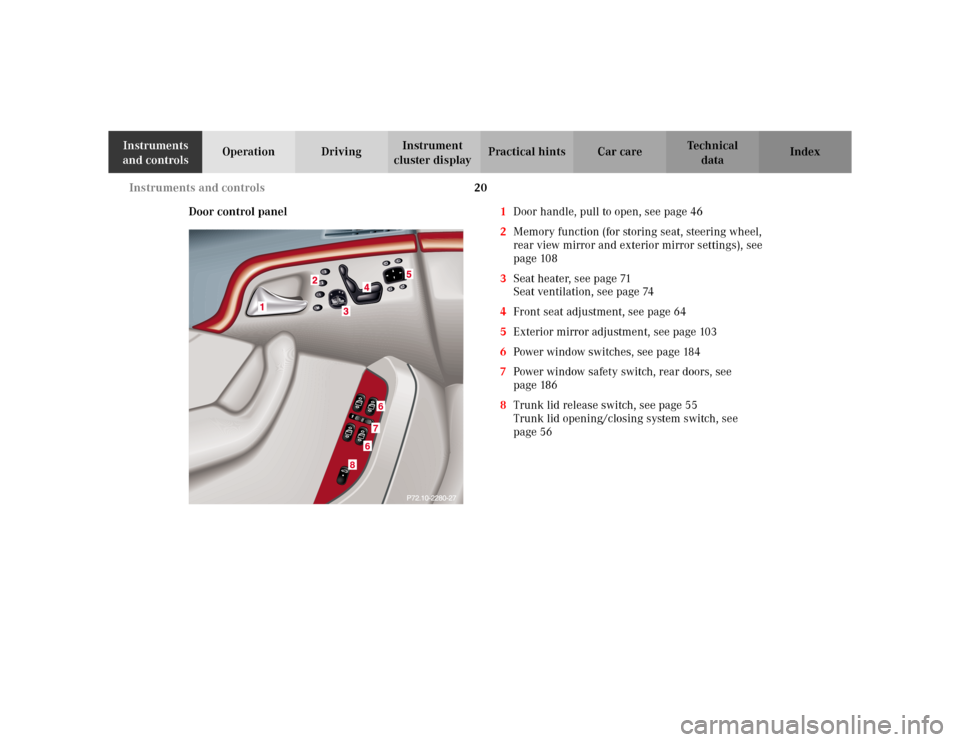
20 Instruments and controls
Te ch n i c a l
data Instruments
and controlsOperation DrivingInstrument
cluster displayPractical hints Car care Index
Door control panel1Door handle, pull to open, see page 46
2Memory function (for storing seat, steering wheel,
rear view mirror and exterior mirror settings), see
page 108
3Seat heater, see page 71
Seat ventilation, see page 74
4Front seat adjustment, see page 64
5Exterior mirror adjustment, see page 103
6Power window switches, see page 184
7Power window safety switch, rear doors, see
page 186
8Trunk lid release switch, see page 55
Trunk lid opening/closing system switch, see
page 56
3
3
3
3
38
76
6
Page 29 of 430
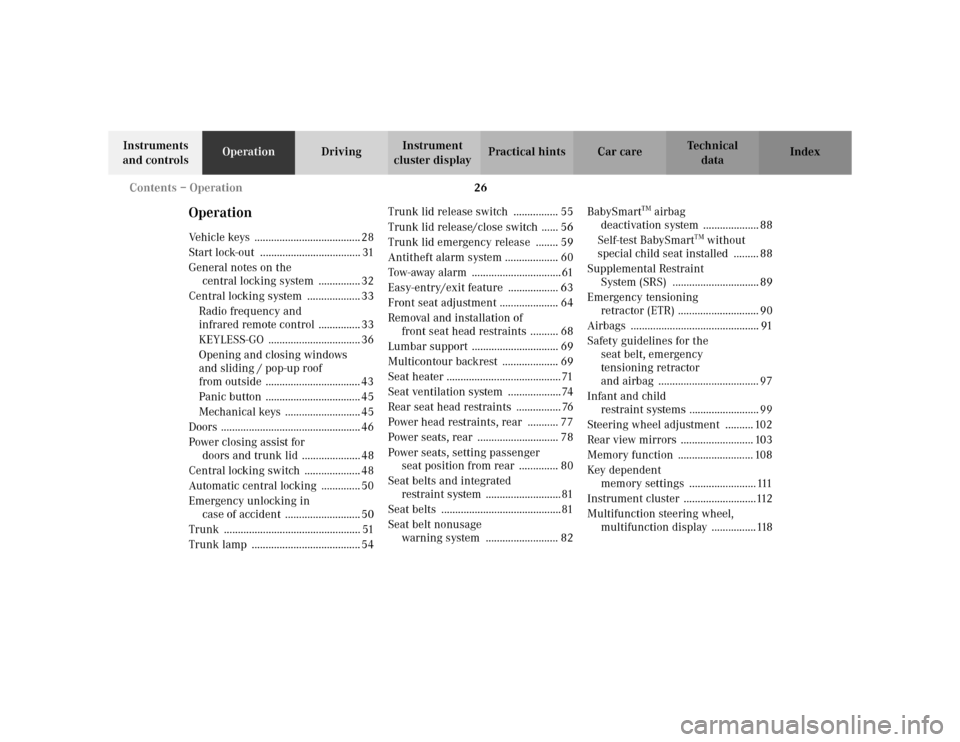
26 Contents – Operation
Te ch n i c a l
data Instruments
and controlsOperationDrivingInstrument
cluster displayPractical hints Car care Index
OperationVehicle keys ...................................... 28
Start lock-out .................................... 31
General notes on the
central locking system ............... 32
Central locking system ................... 33
Radio frequency and
infrared remote control ............... 33
KEYLESS-GO ................................. 36
Opening and closing windows
and sliding / pop-up roof
from outside .................................. 43
Panic button .................................. 45
Mechanical keys ........................... 45
Doors .................................................. 46
Power closing assist for
doors and trunk lid ..................... 48
Central locking switch .................... 48
Automatic central locking .............. 50
Emergency unlocking in
case of accident ........................... 50
Trunk ................................................. 51
Trunk lamp ....................................... 54Trunk lid release switch ................ 55
Trunk lid release/close switch ...... 56
Trunk lid emergency release ........ 59
Antitheft alarm system ................... 60
Tow-away alarm ................................ 61
Easy-entry/exit feature .................. 63
Front seat adjustment ..................... 64
Removal and installation of
front seat head restraints .......... 68
Lumbar support ............................... 69
Multicontour backrest .................... 69
Seat heater ......................................... 71
Seat ventilation system ................... 74
Rear seat head restraints ................ 76
Power head restraints, rear ........... 77
Power seats, rear ............................. 78
Power seats, setting passenger
seat position from rear .............. 80
Seat belts and integrated
restraint system ...........................81
Seat belts ...........................................81
Seat belt nonusage
warning system .......................... 82BabySmart
TM airbag
deactivation system .................... 88
Self-test BabySmart
TM without
special child seat installed ......... 88
Supplemental Restraint
System (SRS) ............................... 89
Emergency tensioning
retractor (ETR) ............................. 90
Airbags .............................................. 91
Safety guidelines for the
seat belt, emergency
tensioning retractor
and airbag .................................... 97
Infant and child
restraint systems ......................... 99
Steering wheel adjustment .......... 102
Rear view mirrors .......................... 103
Memory function ........................... 108
Key dependent
memory settings ........................ 111
Instrument cluster ..........................112
Multifunction steering wheel,
multifunction display ................118
Page 69 of 430
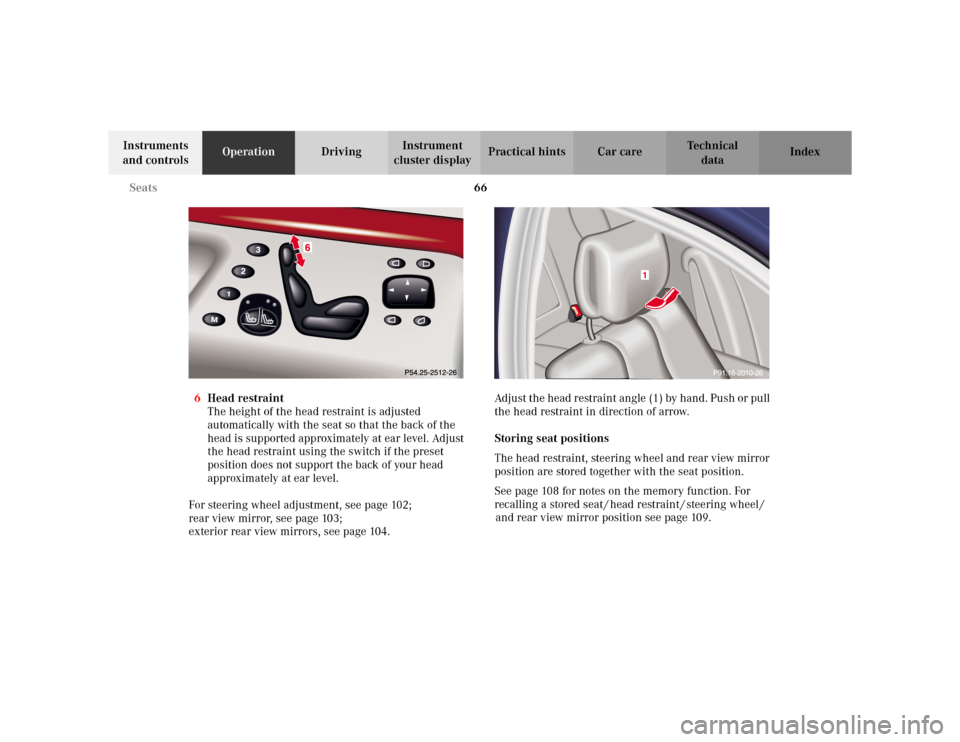
66 Seats
Te ch n i c a l
data Instruments
and controlsOperationDrivingInstrument
cluster displayPractical hints Car care Index
6Head restraint
The height of the head restraint is adjusted
automatically with the seat so that the back of the
head is supported approximately at ear level. Adjust
the head restraint using the switch if the preset
position does not support the back of your head
approximately at ear level.
For steering wheel adjustment, see page 102;
rear view mirror, see page 103;
exterior rear view mirrors, see page 104.Adjust the head restraint angle (1) by hand. Push or pull
the head restraint in direction of arrow.
Storing seat positions
The head restraint, steering wheel and rear view mirror
position are stored together with the seat position.
See page 108 for notes on the memory function. For
recalling a stored seat / head restraint / steering wheel /
and rear view mirror position see page 109.
1
Page 105 of 430
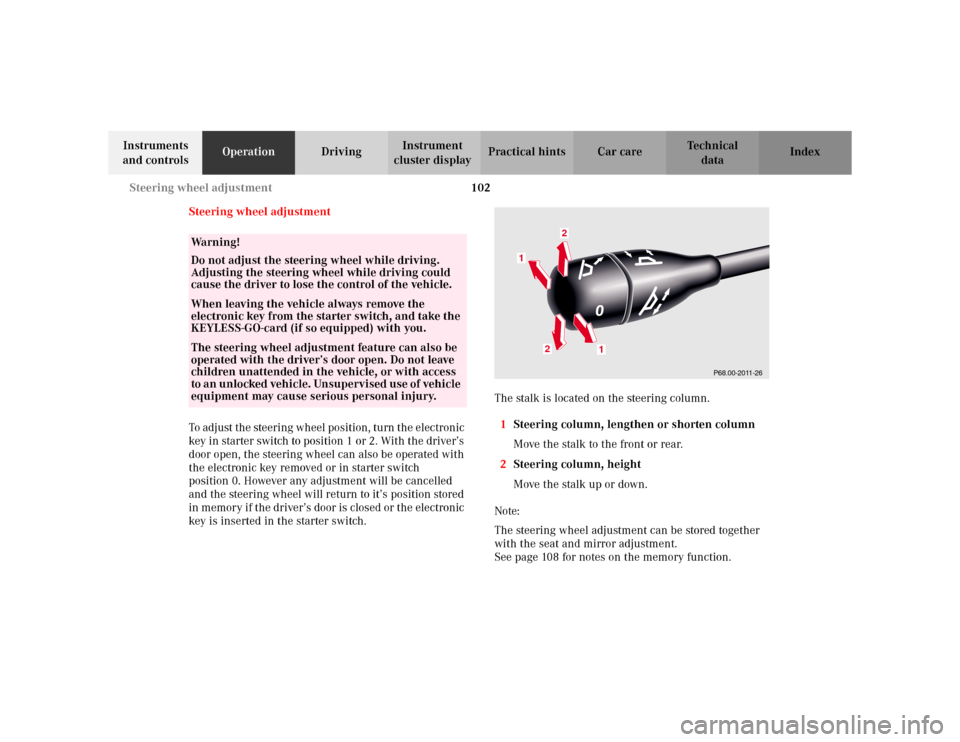
102 Steering wheel adjustment
Te ch n i c a l
data Instruments
and controlsOperationDrivingInstrument
cluster displayPractical hints Car care Index
Steering wheel adjustment
To adjust the steering wheel position, turn the electronic
key in starter switch to position 1 or 2. With the driver’s
door open, the steering wheel can also be operated with
the electronic key removed or in starter switch
position 0. However any adjustment will be cancelled
and the steering wheel will return to it’s position stored
in memory if the driver’s door is closed or the electronic
key is inserted in the starter switch.The stalk is located on the steering column.
1Steering column, lengthen or shorten column
Move the stalk to the front or rear.
2Steering column, height
Move the stalk up or down.
Note:
The steering wheel adjustment can be stored together
with the seat and mirror adjustment.
See page 108 for notes on the memory function.
Wa r n i n g !
Do not adjust the steering wheel while driving.
Adjusting the steering wheel while driving could
cause the driver to lose the control of the vehicle.When leaving the vehicle always remove the
electronic key from the starter switch, and take the
KEYLESS-GO-card (if so equipped) with you. The steering wheel adjustment feature can also be
operated with the driver’s door open. Do not leave
children unattended in the vehicle, or with access
to an unlocked vehicle. Unsupervised use of vehicle
equipment may cause serious personal injury.
P68.00-2011-26
1
1
2
2
Page 106 of 430
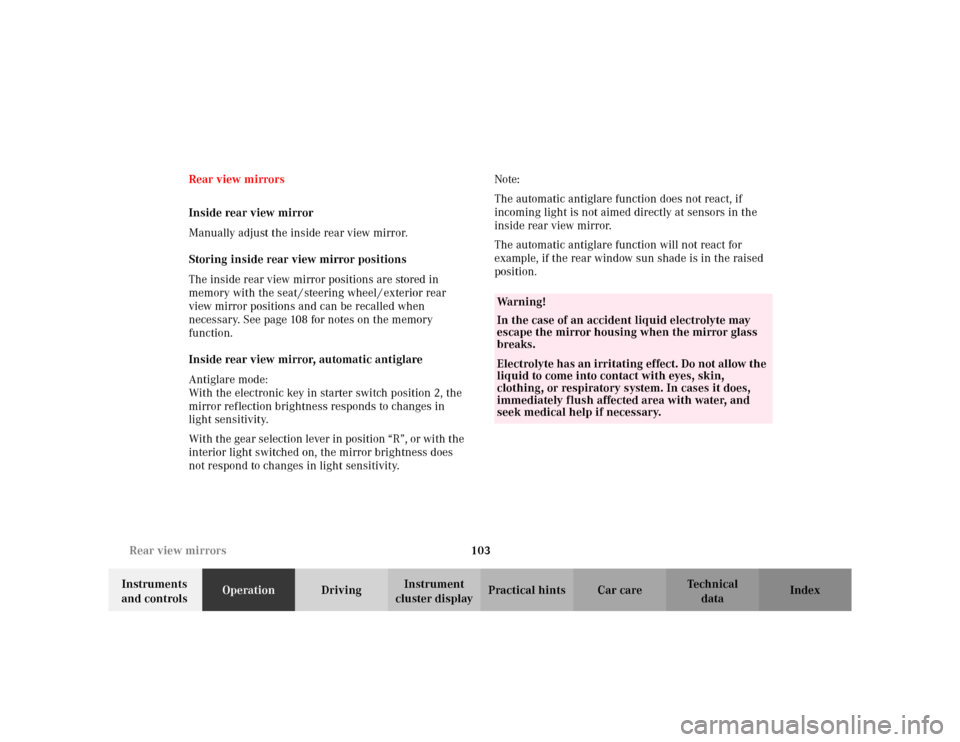
103 Rear view mirrors
Te ch n i c a l
data Instruments
and controlsOperationDrivingInstrument
cluster displayPractical hints Car care Index Rear view mirrors
Inside rear view mirror
Manually adjust the inside rear view mirror.
Storing inside rear view mirror positions
The inside rear view mirror positions are stored in
memory with the seat / steering wheel / exterior rear
view mirror positions and can be recalled when
necessary. See page 108 for notes on the memory
function.
Inside rear view mirror, automatic antiglare
Antiglare mode:
With the electronic key in starter switch position 2, the
mirror reflection brightness responds to changes in
light sensitivity.
With the gear selection lever in position “R”, or with the
interior light switched on, the mirror brightness does
not respond to changes in light sensitivity.Note:
The automatic antiglare function does not react, if
incoming light is not aimed directly at sensors in the
inside rear view mirror.
The automatic antiglare function will not react for
example, if the rear window sun shade is in the raised
position.
Wa r n i n g !
In the case of an accident liquid electrolyte may
escape the mirror housing when the mirror glass
breaks.Electrolyte has an irritating effect. Do not allow the
liquid to come into contact with eyes, skin,
clothing, or respiratory system. In cases it does,
immediately flush affected area with water, and
seek medical help if necessary.
Page 107 of 430
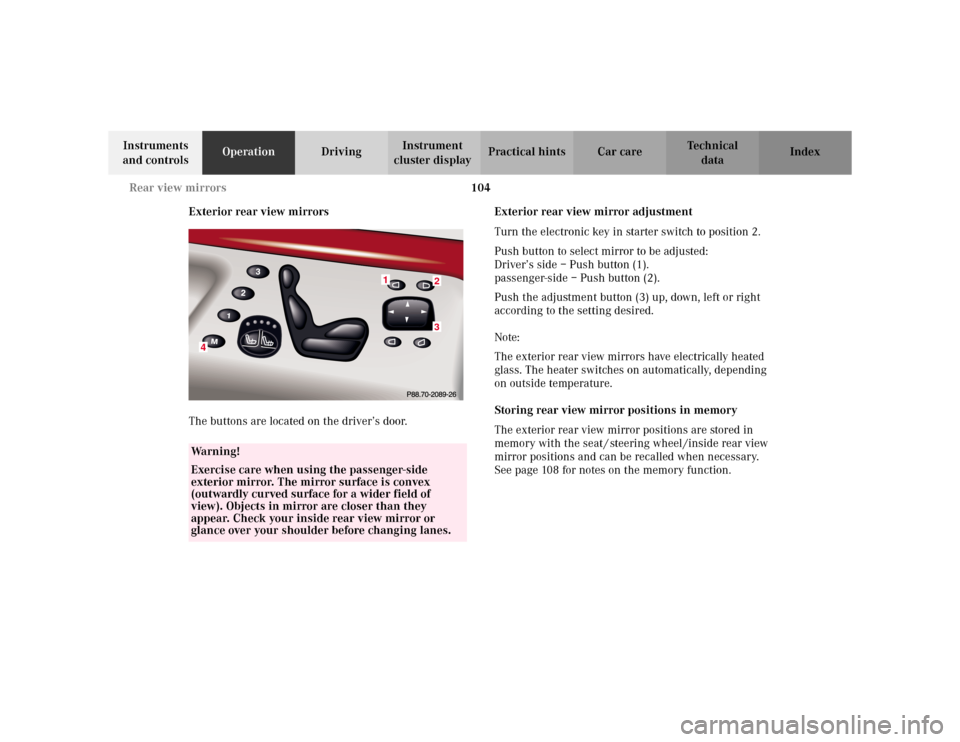
104 Rear view mirrors
Te ch n i c a l
data Instruments
and controlsOperationDrivingInstrument
cluster displayPractical hints Car care Index
Exterior rear view mirrors
The buttons are located on the driver’s door.Exterior rear view mirror adjustment
Turn the electronic key in starter switch to position 2.
Push button to select mirror to be adjusted:
Driver’s side – Push button (1).
passenger-side – Push button (2).
Push the adjustment button (3) up, down, left or right
according to the setting desired.
Note:
The exterior rear view mirrors have electrically heated
glass. The heater switches on automatically, depending
on outside temperature.
Storing rear view mirror positions in memory
The exterior rear view mirror positions are stored in
memory with the seat / steering wheel /inside rear view
mirror positions and can be recalled when necessary.
See page 108 for notes on the memory function.
Wa r n i n g !
Exercise care when using the passenger-side
exterior mirror. The mirror surface is convex
(outwardly curved surface for a wider field of
view). Objects in mirror are closer than they
appear. Check your inside rear view mirror or
glance over your shoulder before changing lanes.
23
4
1
Page 111 of 430
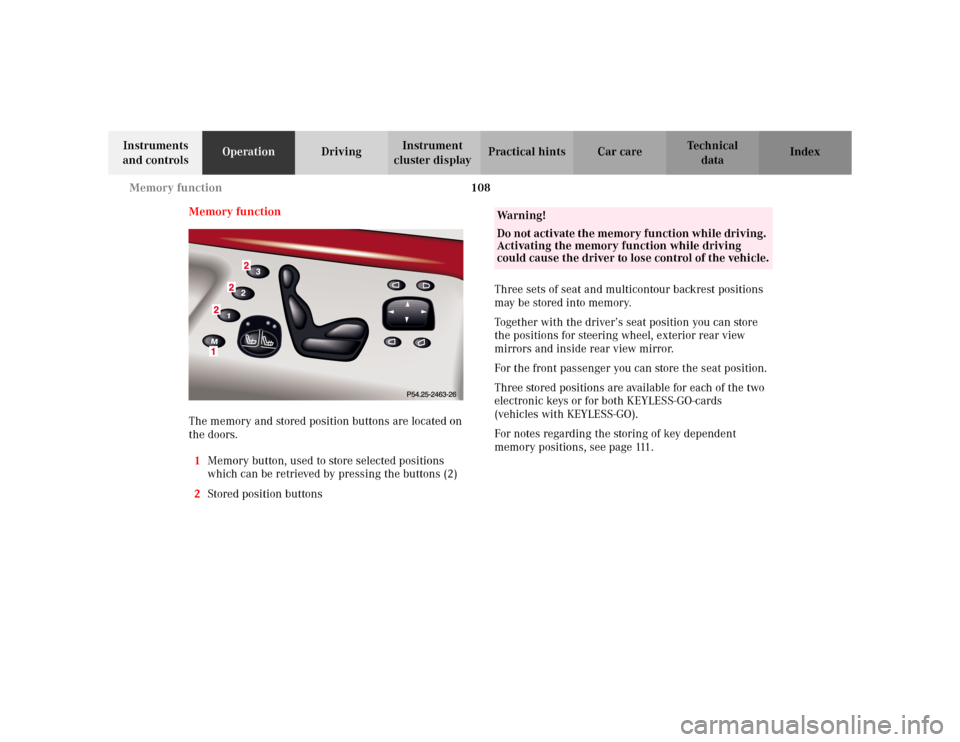
108 Memory function
Te ch n i c a l
data Instruments
and controlsOperationDrivingInstrument
cluster displayPractical hints Car care Index
Memory function
The memory and stored position buttons are located on
the doors.
1Memory button, used to store selected positions
which can be retrieved by pressing the buttons (2)
2Stored position buttonsThree sets of seat and multicontour backrest positions
may be stored into memory.
Together with the driver’s seat position you can store
the positions for steering wheel, exterior rear view
mirrors and inside rear view mirror.
For the front passenger you can store the seat position.
Three stored positions are available for each of the two
electronic keys or for both KEYLESS-GO-cards
(vehicles with KEYLESS-GO).
For notes regarding the storing of key dependent
memory positions, see page 111.
Wa r n i n g !
Do not activate the memory function while driving.
Activating the memory function while driving
could cause the driver to lose control of the vehicle.
Page 112 of 430
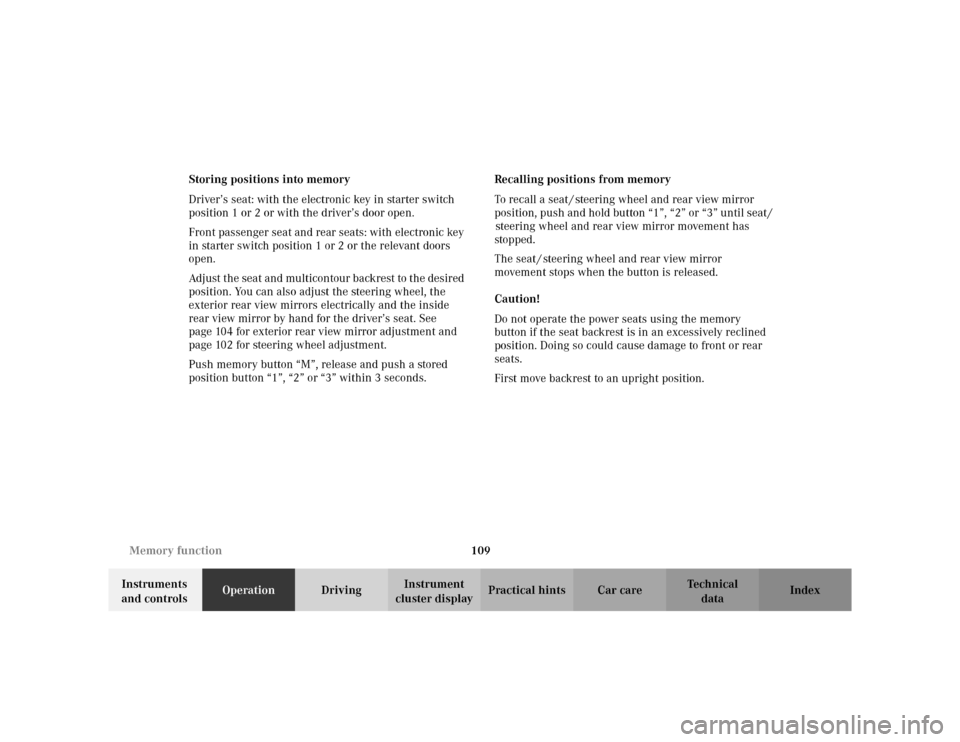
109 Memory function
Te ch n i c a l
data Instruments
and controlsOperationDrivingInstrument
cluster displayPractical hints Car care Index Storing positions into memory
Driver’s seat: with the electronic key in starter switch
position 1 or 2 or with the driver’s door open.
Front passenger seat and rear seats: with electronic key
in starter switch position 1 or 2 or the relevant doors
open.
Adjust the seat and multicontour backrest to the desired
position. You can also adjust the steering wheel, the
exterior rear view mirrors electrically and the inside
rear view mirror by hand for the driver’s seat. See
page 104 for exterior rear view mirror adjustment and
page 102 for steering wheel adjustment.
Push memory button “M”, release and push a stored
position button “1”, “2” or “3” within 3 seconds.Recalling positions from memory
To recall a seat / steering wheel and rear view mirror
position, push and hold button “1”, “2” or “3” until seat /
steering wheel and rear view mirror movement has
stopped.
The seat / steering wheel and rear view mirror
movement stops when the button is released.
Caution!
Do not operate the power seats using the memory
button if the seat backrest is in an excessively reclined
position. Doing so could cause damage to front or rear
seats.
First move backrest to an upright position.
Page 113 of 430
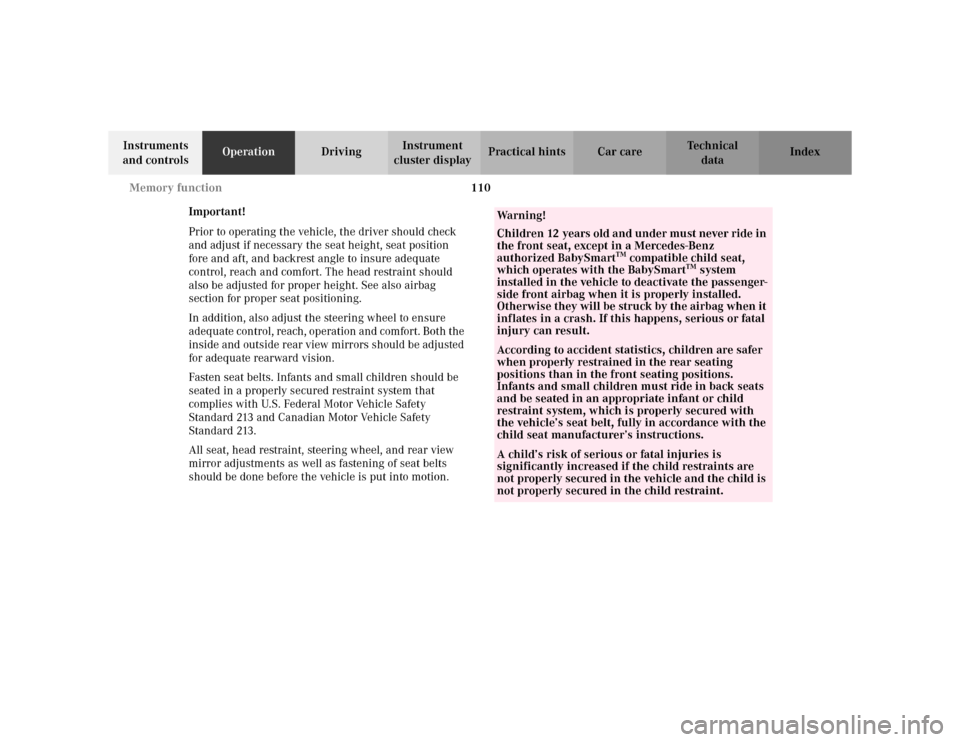
110 Memory function
Te ch n i c a l
data Instruments
and controlsOperationDrivingInstrument
cluster displayPractical hints Car care Index
Important!
Prior to operating the vehicle, the driver should check
and adjust if necessary the seat height, seat position
fore and aft, and backrest angle to insure adequate
control, reach and comfort. The head restraint should
also be adjusted for proper height. See also airbag
section for proper seat positioning.
In addition, also adjust the steering wheel to ensure
adequate control, reach, operation and comfort. Both the
inside and outside rear view mirrors should be adjusted
for adequate rearward vision.
Fasten seat belts. Infants and small children should be
seated in a properly secured restraint system that
complies with U.S. Federal Motor Vehicle Safety
Standard 213 and Canadian Motor Vehicle Safety
Standard 213.
All seat, head restraint, steering wheel, and rear view
mirror adjustments as well as fastening of seat belts
should be done before the vehicle is put into motion.
Wa r n i n g !
Children 12 years old and under must never ride in
the front seat, except in a Mercedes-Benz
authorized BabySmart
TM compatible child seat,
which operates with the BabySmart
TM system
installed in the vehicle to deactivate the passenger-
side front airbag when it is properly installed.
Otherwise they will be struck by the airbag when it
inflates in a crash. If this happens, serious or fatal
injury can result.
According to accident statistics, children are safer
when properly restrained in the rear seating
positions than in the front seating positions.
Infants and small children must ride in back seats
and be seated in an appropriate infant or child
restraint system, which is properly secured with
the vehicle’s seat belt, fully in accordance with the
child seat manufacturer’s instructions.A child’s risk of serious or fatal injuries is
significantly increased if the child restraints are
not properly secured in the vehicle and the child is
not properly secured in the child restraint.